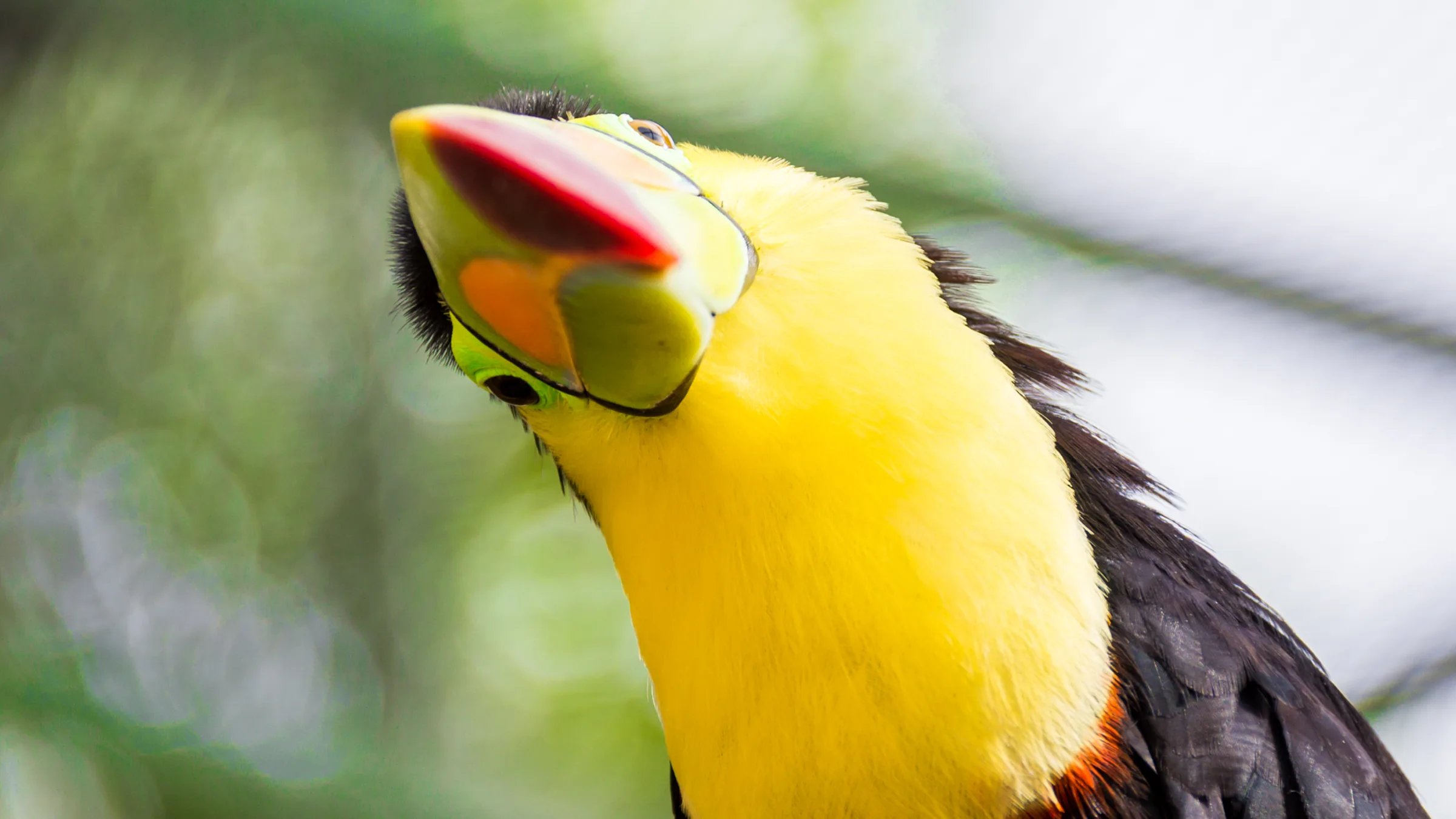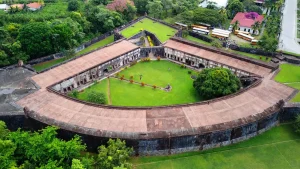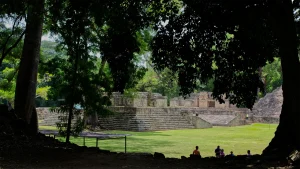Nature Activities in Honduras

Nature and Geotourism
Copán Ruinas, Copán
It is one of the most important tourist sites in Honduras. Birds, nature reserves, coffee plantations, hot springs, landscapes and country life complement the tourist attraction of an area where researchers continue to harvest finds, decipher stories and reconstruct more of the life of the Mayans of the southernmost part of Mesoamerica .
The architecture and sculpture of this political and ceremonial center of the classical period reach levels unprecedented in other Mayan cities. You can appreciate part of them in the museum and walk another among trees and animals, or underground.
Cabañas Fort and K’inich House
It is a military building built in 1940 for the Honduran armies stationed in Copán Ruinas in order to safeguard the western borders. It was baptized in honor of General José Trinidad Cabañas. Since 2002 it houses the Casa K’inich Interactive Learning Museum (Casa del Sol), a “museum for children” under the patronage of the Copán Association.
Guacamaya Mountain Bird Park, Copán Ruinas, Copán
The Montaña Guacamaya Bird Park and Natural Reserve is an attraction, a center for conservation and breeding, rehabilitation and a bird lodge that awaits you a few kilometers from the center of Copán Ruinas, on the road that leads to Aguas Calientes.
A colorful ecological park surrounded by centenary native trees and a coffee farm, and crossed in the middle by the refreshing waters of the Cakaguatales stream, on which you can have breakfast, snack or lunch after walking among more than 180 species of Honduran birds. Central American and some South American. Do not miss the opportunity to feel how the legs of a red, green or blue guara rest on your arms, your shoulders or your head while they spread their wings wide. This is the best time to take a photo of your vacation worth sharing with your friends.
Valle de Angeles Tourist Park
Better known as the «Parque Obrero», it is a place of recreation and rest in the middle of pine forests, ideal for walks and celebrations with family and friends in a country setting. It is located less than half an hour from Tegucigalpa.
La Tigra National Park
This cloud forest offers you several ways to enjoy it, if you are interested in nature or excited about adventure. Eight trails, with varying degrees of difficulty, run through the 240 km2 evergreen and humid park, the main source of water in Tegucigalpa.
Here lives the winged jewel of the isthmus, the quetzal, which you can always find in the mist, with enough patience and fortune. You can also see toucans and hawks, felines such as tigrillos, pumas and jaguarondis, and various kinds of amphibians and reptiles. The walls and roof of this biodiverse refuge are laid out by pine trees, sweetgum trees and other species of trees, generally covered with mosses, and, more at ground level, there are plants, among them 6 kinds of ferns in danger of extinction.
The impressive variety of insects, including many that have not been seen in the region, is another wealth of the park that you can find while looking for the colors of the quetzal, the blue butterfly or the tigrillos, and discover the dimension that the word takes here » lifetime».
Capiro and Calentura National Park
It is located between the municipalities of Trujillo and the Garífuna Community of Santa Fe, department of Colón, in the final part of the Nombre de Dios Mountain Range. Located 4 kilometers south of the city of Trujillo, it is a beautiful and impressive mountain massif of exuberant vegetation and a great diversity of wildlife, such as the howler and white-faced monkey, raccoons, jaguars, ocelots, reptiles, snakes, deer, insects, orioles, toucans, parrots, and macaws among others. In addition to its immense biodiversity, in Capiro y Calentura National Park you can also enjoy the spectacular beauty of the Río Negro Waterfall.
San Fernando de Omoa Water Park
It is also included with a curious replica of the fortress, characteristic of that coastal city. You can enjoy 18 hectares with trails, ideal for family relaxation.
Yojoa lake
It is the only lake of volcanic origin in Honduras and the largest reserve of fresh water in the country. In 2005 it was recognized as a Wetland of World Interest by the UN, through the RAMSAR convention. The place offers tourists multiple options to spend several days in the area with a wide variety of restaurants, recreation centers with swimming pools and water entertainment, and zoos.
Bioparque Paradise, Lake Yojoa
BioParque and Finca de Café y Flores «Paradise» is a beautiful site of conservation and natural production, located in Aldea Los Naranjos. The Blanco or Helado River and 5 water sources enliven its natural forests of colored wood trees, exotic orchids and an interesting diversity of birds and minor fauna, such as guatusas, iguanas and squirrels.
Walking along the natural trails that cross its coffee plantations and tropical flower crops is a pleasant encounter with nature. You will also come across mounds and ball courts from the millenary Lenca civilization (900-1550). You can stay in its cabins or rooms, or camp in it.
Butterfly Farm, Lake Yojoa
It shows you a collection of live or stuffed butterflies, among which there are 11 from the area. It is within the La Naturaleza Tourist Complex, in front of Lake Yojoa from the CA-5 highway (km 160, at the height of Aldea El Cacao), and is managed by Aldea Global, the NGO also in charge of protecting the Cerro National Park Meambar Blue. Five experts work with species in the lake basin, especially endangered ones, such as the blue morpho and the four-mirror butterflies.
Cerro Azul Meámbar National Park – PANACAM, Lake Yojoa
Get in touch with the art of nature with a majestic coverage of deep blue. Cerro Azul Meámbar National Park offers trails that take you to intimately explore its flora and fauna. And for those who love adrenaline, there is a high-speed canopy tour that satisfies the senses.
Los Naranjos Archaeological Park, Yojoa Lake
There is a magical experience in the Los Naranjos Archaeological Park , visit us and discover it for yourself. You will find beautiful trails, unforgettable views of Lake Yojoa and a cozy visitor center with a charismatic and intimate museum.
Pulhapanzak Falls, Yojoa Lake
When the Rio Lindo course runs out of soil, it drops 43 meters at Pulhapanzak with enough flow to cause a ‘roar’ carried by the fine breeze that is felt some distance from the falls. The spa also offers you a farm where you can share in the milking of cows and the manufacture of cheese, as well as lodging in cabins.
Somewhat less well known is that on the site there are important pre-Columbian traces of a stone causeway and a plaza surrounded by 4 mounds from the classical period (600-900 BC). The Rio Lindo continues its course with some fast sections that you can go down on a giant float (river tubing) for 2 hours.
La Ceiba, Atlantida
It is the third largest city in Honduras. It has several attractions and its people are not just one more: joy and rhythm welcome the traveler all year round. With unique attractions such as the Pico Bonito National Park, the Cangrejal River and the La Ceiba Carnival, the city promises a pleasant time full of fun and adventure.
Swinford Park, Atlantis
Besides being a beautiful garden, it is a small open-air museum where old wagons and two of the old railroad machines that circulated through the city and the surroundings in the golden years of the banana era are exhibited. This is why Swinford Park is an important site that you must visit when you come to La Ceiba, since you can learn part of its history while relaxing and enjoying the natural environment it has. It has a beautiful garden with a wide variety of plants and flowers that make it a quiet place to spend a moment of relaxation.
Leather and Salado Wildlife Refuge, Atlántida
If you always dreamed of joining the jungle, this wildlife refuge hides a reserve of beautiful animals and exotic plants. Here you can observe a diversity of fauna such as howler monkeys, white-faced monkeys, herons and other native birds of coastal areas. An experience that you can only live in Honduras.
Pico Bonito National Park, La Ceiba, Atlántida
This protected area is one of the richest national parks in biodiversity in Honduras. A place for adventure, encounters with nature or with oneself, and experiences as diverse as the life that inhabits it in many ways. It climbs from the coast to 2,485 meters above sea level at its highest peak, with different types of forests from where fast rivers such as the Cangrejal flow down to the Caribbean Sea, which flow with powerful currents ideal for rafting; or like the mighty ones that form refreshing pools and waterfalls.
It is also home to exciting sections of canopy, suspension bridges and numerous wildlife, plant and animal species: jaguars, pumas, tigrillos, white-faced and howler monkeys, tapirs, anteaters and white-tailed deer, boas, yellow and coral beard snakes, quetzals, goldfinches and many more, several in danger of extinction, in addition to hundreds of species of flora.
Jeannette Kawas National Park (Punta Sal), Atlántida
- Tourism in Jeannette Kawas Park (Punta SAL)
We have a gift of nature for you: more than five ecosystems to experience white sand beaches, mangrove forests and coral reefs, to mention just a few of all the attractions that are part of this wonderful park. The wildlife of the peninsula is simply spectacular: jaguars, howler monkeys and boas are characters of this jungle. Famous for being a ‘hot spot’ for bird watching during the months of October to January.
The Lancetilla Botanical Garden, Tela, Atlántida
It is the second largest tropical garden in the world. It has the largest collection of exotic plants in Latin America, with native species from Oceania, Africa and Asia, and serves as a home or refuge for more than 300 species of birds.
The banana company created it in 1925 in the Lancetilla Valley as a research center in which they also experiment with tropical plants with economic potential. It is a few minutes from the center of Tela and the natural warheads into which the bamboo bends at its entrance, the “Bamboo Tunnel”, have already become an icon of the garden and the city.
El Cusuco National Park
About 40 km to the west you find this protected area that descends towards the Caribbean through the Sierra de Omoa and takes the popular name of the armadillo: cusuco. A rich area of rugged cloud forest, between 1800 and 2200 meters above sea level, which shelters more than 90 species of reptiles and amphibians and more than 35 of bats, and in which 270 species of birds have been identified so far.
Jaguars and tigrillos share the biodiverse flora that surrounds the park with tapirs, monkeys, guatusas and two of the animal jewels of El Cusuco: the quetzal and the emerald beetles. Here you also find giant ferns like trees, up to 20 meters. Walking its trails between rain or mist is a pleasant adventure that you can take even further if you decide to spend the night and camp.
Rawacala Ecotour
An eco-tourism project in a private reserve, where it is possible to hike through the mountains, swim in a waterfall with crystal clear water and slide through the tops of tall trees, with the help of canopy hooks and pulleys.
Laguna de Guaimoreto Wildlife Refuge
It is the habitat of several marine and aquatic species, crocodiles, monkeys, iguanas and fish. Broadleaf forest, floating plants, flooded forest, mangroves and sand plants surround this lagoon that empties into the Bay of Trujillo. Among the activities that can be carried out are the boat rides through the lagoon visiting the mangroves until reaching the mouth of the bay, as well as the observation of marine and migratory birds.
Taulabé Caves, Comayagua
They are a stone labyrinth, the result of the dissolution of the limestone rock mantle by the action of water. Although 12 km have been explored, its full extent is not yet known. The first 100 m are enabled for your visit through a path equipped with handrails and lighting.
Here you find stalactites and stalagmites that condense a trickle of millions of years. The most famous is the “Angel Wing”, a stalactite over 3 m long and 4 tons in weight that seems to float very close to the ceiling of the cave.
The Mosquitia
The most remote area of Honduras is also the most biodiverse and the one with the highest ethnic concentration. Here is the largest tropical rainforest in America after the Amazon, formed by the Río Plátano Biosphere Reserve, a World Heritage Site; the Patuca National Park, the Tawakha Anthropological Reserve, the Cruta Caratasca Wildlife Refuge and the Rus Rus Biological Reserve.
Venturing in La Mosquitia, assisted by expert guides, is exploring one of the most extreme areas of the continent. On the other side of the village of Las Marías you enter a world without time in which the trees do not let you see the sun, you live with wild animals and travel downriver, overcoming jungle, savannas and lagoons, until you reach the Caribbean to tell what It could be the best adventure of your life.




